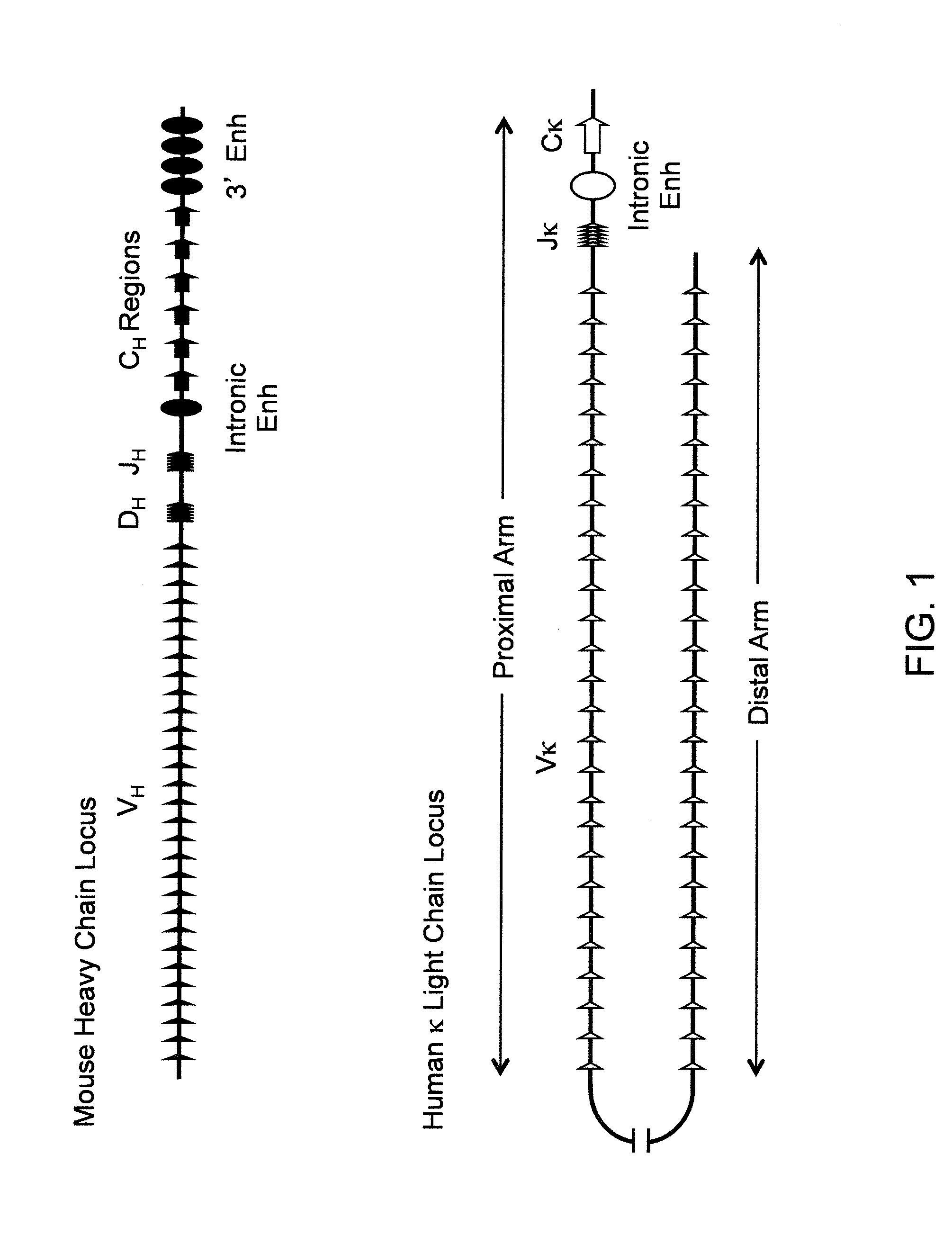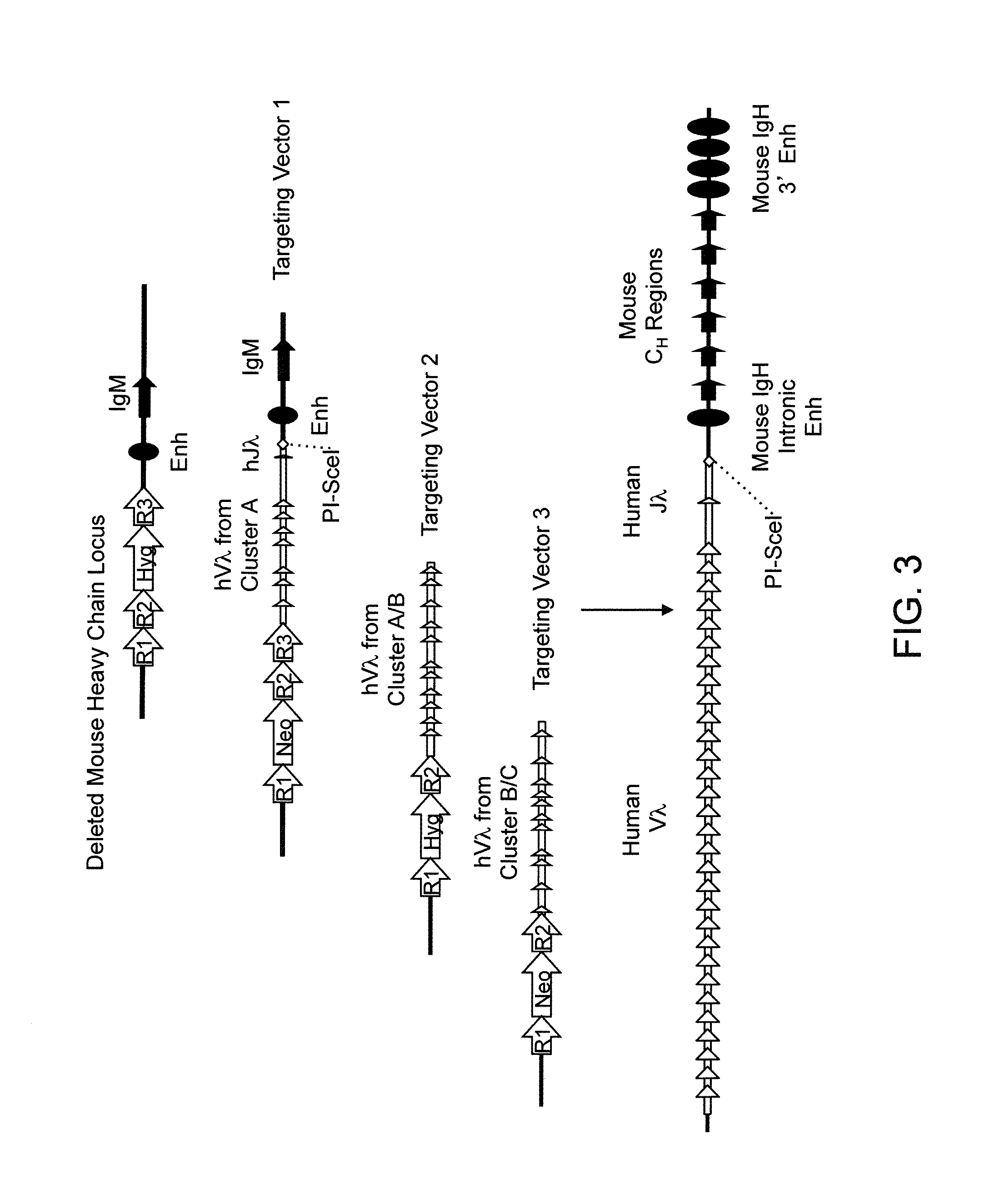Humanized Rodents that Express Heavy Chain Containing VL Domains
a technology of vl domains and humanized rodents, which is applied in the field of humanized rodents that express vl domains, can solve the problems of unsatisfactory long-term treatment regimens, and unsatisfactory early antibody therapeutics based on mouse antibodies, so as to improve fertility and reduce the effect of fertility loss and fertility restoration
- Summary
- Abstract
- Description
- Claims
- Application Information
AI Technical Summary
Benefits of technology
Problems solved by technology
Method used
Image
Examples
example 1
Introduction of Human Light Chain Gene Segments into a Heavy Chain Locus
[0508]Various targeting constructs were made using VELOCIGENE® genetic engineering technology (see, e.g., U.S. Pat. No. 6,586,251 and Valenzuela et al. (2003), High-throughput engineering of the mouse genome coupled with high-resolution expression analysis, Nat Biotechnol 21:652-659) to modify mouse genomic Bacterial Artificial Chromosome (BAC) libraries. Mouse BAC DNA was modified by homologous recombination to inactivate the endogenous heavy chain locus through targeted deletion of VH, DH and JH gene segments for the ensuing insertion of unrearranged human germline κ light chain gene sequences (e.g., see top of FIG. 2).
[0509]Briefly, the mouse heavy chain locus was deleted in two successive targeting events using recombinase-mediated recombination. The first targeting event included a targeting at the 5′ end of the mouse heavy chain locus using a targeting vector comprising from 5′ to 3′ a 5′ mouse homology ar...
example 2
Identification of Targeted ES Cells and Generation of Genetically Modified Mice Bearing Human Light Chain Gene Segments at an Endogenous Heavy Chain Locus
[0523]The targeted BAC DNA made in the foregoing Examples is used to electroporate mouse ES cells to created modified ES cells for generating chimeric mice that express VL binding proteins (i.e., human κ light chain gene segments operably linked to mouse heavy chain constant regions). Targeted ES cells containing an insertion of unrearranged human κ light chain gene segments are identified by a quantitative PCR assay, TAQMAN® (Lie, Y. S., and Petropoulos, C. J. (1998) Advances in quantitative PCR technology: 5′ nuclease assays. Curr Opin Biotechnol 9(1): 43-48). Specific primers sets and probes are designed to detect insertion of human κ sequences and associated selection cassettes, loss of mouse heavy chain sequences and retention of mouse sequences flanking the endogenous heavy chain locus.
[0524]ES cells bearing the human κ light...
example 3
Propagation of Mice Expressing VL Binding Proteins
[0527]To create a new generation of VL binding proteins, mice bearing the unrearranged human κ gene segments can be bred to another mouse containing a deletion of the opposite or untargeted endogenous heavy chain allele (i.e., a mouse heterozygous for the modification). In this manner, the progeny obtained would express only hybrid heavy chains as described in Example 1. Breeding is performed by standard techniques recognized in the art and, alternatively, by commercial companies, e.g., The Jackson Laboratory. Mouse strains bearing a modified heavy chain locus are screened for presence of the unique heavy chains containing human light chain variable domains.
[0528]Alternatively, mice bearing the unrearranged human ∂ gene segments at the mouse heavy chain locus can be optimized by breeding to other mice containing one or more deletions in the mouse light chain loci (κ and λ). In this manner, the progeny obtained would express unique hu...
PUM
| Property | Measurement | Unit |
|---|---|---|
| Light | aaaaa | aaaaa |
Abstract
Description
Claims
Application Information
 Login to View More
Login to View More - R&D
- Intellectual Property
- Life Sciences
- Materials
- Tech Scout
- Unparalleled Data Quality
- Higher Quality Content
- 60% Fewer Hallucinations
Browse by: Latest US Patents, China's latest patents, Technical Efficacy Thesaurus, Application Domain, Technology Topic, Popular Technical Reports.
© 2025 PatSnap. All rights reserved.Legal|Privacy policy|Modern Slavery Act Transparency Statement|Sitemap|About US| Contact US: help@patsnap.com



